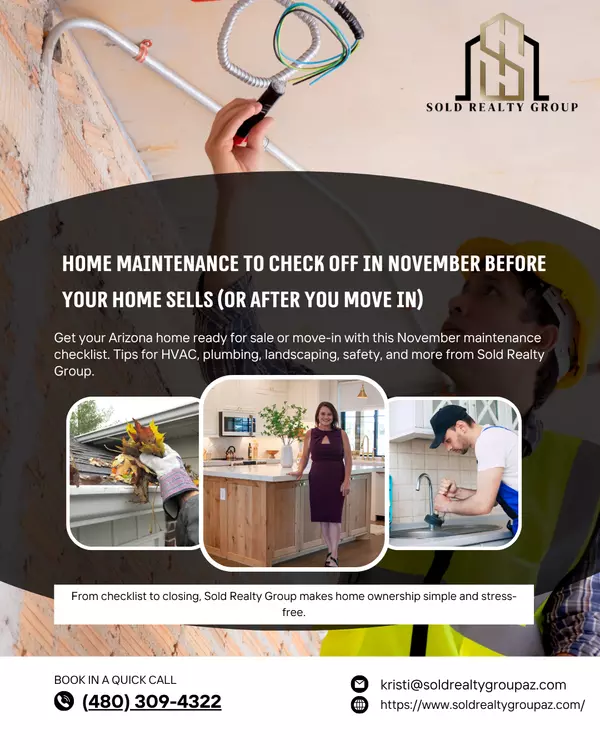How to Negotiate Repairs Without Losing the Deal
by Kristi Damon
Your Guide to Post-Inspection Power Moves — from Sold Realty Group
You’ve made it past the offer stage, the inspection is done… and now you’re staring at a report with 45 pages of "issues." Don’t panic—this is completely normal. The post-inspection phase is where buyers and sellers have the chance to work together and make the deal feel right for both sides.
The goal? Get necessary repairs handled without killing the deal or overplaying your hand. Here's how to walk that fine line like a pro.
🧰 Step 1: Understand What’s Actually Important
Inspection reports can look scary. But keep in mind—they often list everything, from minor wear-and-tear to serious structural issues. Not everything needs to be fixed before closing.
✅ Focus on:
-
Major safety issues (electrical hazards, gas leaks)
-
Structural concerns (roof, foundation, plumbing)
-
Code violations or things that may affect insurability
-
High-cost systems near end of life (HVAC, water heater)
🚫 Skip nitpicking:
-
Chipped paint
-
Loose doorknobs
-
Small cosmetic flaws
This isn’t your chance to create a punch list for a perfect home. It's about protecting your investment.
🤝 Step 2: Be Realistic and Professional in Your Ask
Sellers are more likely to work with buyers who approach repair negotiations with fairness. Present your requests in a clear, reasonable format. Your agent (hi, that’s where we come in 😉) can help craft the right tone and strategy.
Common ways to request repairs:
-
Ask the seller to complete specific repairs before closing
-
Request a credit or price reduction so you can handle repairs yourself
-
A mix of both, depending on urgency or cost
💡 Tip: Credits are often cleaner—less risk of delays from repair scheduling and contractor timelines.
💬 Step 3: Communicate With Strategy, Not Emotion
This isn’t the time to threaten to walk or get overly emotional about imperfections. It’s business. And like any good business deal, tone matters.
Let your agent lead the discussion. We’ll advocate firmly while keeping the conversation productive and collaborative. Most sellers want to make the deal work—especially if the requests are fair.
📝 Step 4: Back Up Your Requests With Evidence
The best way to support your repair request? Attach excerpts from the inspection report. If a contractor estimate is needed (for something big like a roof or HVAC), we’ll help get one to show the real cost.
Sellers are more likely to say “yes” when they see:
-
Clear documentation
-
Reasonable pricing
-
That you're not just making a wish list
🧠 Step 5: Know When to Push—and When to Let Go
It’s easy to fall in love with a home and get frustrated when the seller pushes back. But remember: no home is perfect. If you’ve negotiated for major safety or system issues and the seller meets you halfway, that’s a win.
Sometimes walking away is right—but often, keeping the bigger picture in mind is better. Your dream home might just need a little TLC, and with a good strategy, you can handle it on your terms.
👋 Final Thought: You Don’t Have to Navigate This Alone
Post-inspection negotiations can be one of the trickiest parts of the buying process. But that’s why working with an experienced real estate agent matters. At Sold Realty Group, we’ve been through this hundreds of times—and we know how to protect your interests without blowing the deal.
Let us guide you through the negotiation table with clarity, calm, and confidence.
📍 Mesa & the East Valley | Serving Phoenix, San Tan Valley & Beyond
📞 Call/Text April at (480) 309-4322
🌐 soldrealtygroupaz.com
📧 [email protected]
Real Estate Done Differently—because the deal doesn’t end with the offer.
Would you like this turned into a downloadable "Post-Inspection Checklist" or quick-reference email template for clients?
You said:
ChatGPT said:
Absolutely, April! Here's an expanded version of your blog post:
“How to Negotiate Repairs Without Losing the Deal”
This version includes additional tips, buyer psychology, seller strategies, and real-world examples to make the guide more comprehensive and helpful for your readers.
How to Negotiate Repairs Without Losing the Deal
A Practical Guide to Navigating the Post-Inspection Phase with Confidence – by Sold Realty Group
You’ve found the home. The offer’s accepted. You’re picturing your furniture in the living room.
Then… the inspection report lands in your inbox, and it’s 60 pages long.
Take a breath. This is one of the most important (and misunderstood) parts of the homebuying journey: the post-inspection negotiation.
Many deals fall apart during this phase—not because the house is bad, but because buyers and sellers don’t know how to handle repair requests with clarity and compromise. So how do you get what you need without spooking the seller or losing the home?
Let’s break it down.
🕵️♀️ Step 1: Understand the Purpose of the Inspection
Here’s what it’s not:
-
A to-do list for the seller
-
An excuse to renegotiate everything
-
A way to get a “perfect” home
Here’s what it is:
✔️ A tool to identify significant issues
✔️ A chance to protect your investment
✔️ An opportunity to address safety concerns before closing
Your inspector will find something—they always do. Even brand-new homes have quirks. The key is separating serious concerns from livable imperfections.
🔍 Step 2: Sort the Issues into 3 Buckets
Bucket 1: Must-Fix (Health, Safety, Structural)
Examples:
-
Active roof leaks
-
Outdated or dangerous electrical wiring
-
Foundation cracks
-
HVAC not working
-
Gas leaks or plumbing failures
📌 These are the types of repairs worth negotiating—hard stops for most lenders and buyers.
Bucket 2: Could-Fix (Moderate, Non-Cosmetic Repairs)
Examples:
-
Old water heater near end of life
-
Windows that don’t open
-
Appliances not functioning
-
Grading that slopes toward the home
📌 These are negotiable—great for asking for credits or split solutions.
Bucket 3: Don’t-Fix (Cosmetic or Minor Wear)
Examples:
-
Loose cabinet hinges
-
Peeling paint
-
Scuffed baseboards
-
Worn carpet
📌 Avoid wasting leverage here. Save your energy for what matters.
💬 Step 3: Decide How to Ask—Repair vs. Credit
Once you’ve narrowed down your reasonable requests, it’s time to choose your negotiation path:
Option 1: Seller Makes Repairs
Good for buyers who want move-in ready convenience.
⚠️ Risk: Delays or low-quality work if sellers rush repairs.
Option 2: Seller Offers Credit or Price Reduction
Preferred by many buyers so they can control the quality, timing, and vendor.
⚠️ Credit must be approved by your lender and factored into the closing paperwork.
Option 3: Hybrid Approach
Ask for a credit on big-ticket items, and request seller fixes for safety issues (like a GFCI outlet or carbon monoxide detector).
💡 Pro Tip: Credits often make deals smoother and faster.
🧠 Step 4: Use the Right Tone and Strategy
Repair negotiations are part business, part psychology. Keep your tone respectful, not demanding. You want the seller to feel you're being fair, not nitpicky or opportunistic.
Here’s what works:
-
Be specific: “We’re requesting a $2,000 credit for the aging water heater and HVAC repairs noted on p. 12 of the report.”
-
Show documentation: Attach inspection photos and notes.
-
Be solutions-focused: “We’re hoping to work together to keep this moving forward smoothly.”
Here’s what doesn’t work:
-
Threatening to walk for minor issues
-
Sending an overwhelming list of fixes
-
Getting emotional or accusatory
At Sold Realty Group, we help coach this conversation every step of the way—protecting your interests while keeping the seller at the table.
🧾 Step 5: Leverage, But Don’t Over-Leverage
It’s okay to negotiate—but don’t use the inspection as a way to reopen every part of the deal. Most sellers expect to contribute something post-inspection—but if they feel nickel-and-dimed, they may walk or refuse.
🔑 Ask yourself:
-
Would I walk away from this house over this issue?
-
Is the home still a good value with this repair?
-
Can I live with it and fix it later on my terms?
Often, a $1,500 repair isn’t worth losing a home you love.
🛠️ Real-World Example: Smart Repair Strategy
The Situation:
Inspection reveals an aging roof, faulty GFCI outlets, and a dishwasher that doesn’t drain.
Bad Ask:
“We want the roof replaced, all appliances brand-new, and the house professionally repainted.”
Smart Ask:
“We’re requesting a $5,000 credit toward future roof replacement and a licensed electrician to address the GFCI issues before closing. We’ll handle the dishwasher ourselves.”
Result? The seller agrees. The deal stays alive. Everyone wins.
🙌 Final Step: Trust the Process—And Your Agent
Repair negotiations can feel stressful, especially if you’re emotionally attached to the home. That’s why you need a strong, clear-minded guide on your side.
At Sold Realty Group, we bring negotiation experience, local vendor contacts, and calm strategy to the table. You won’t go through this alone—we’ll help you protect your investment and keep your dream home within reach.
Ready to Buy with Confidence?
Let’s talk about how we handle inspections, repairs, and all the “what-ifs” that come with buying a home in Arizona.
📍 Based in Mesa | Serving Phoenix, San Tan Valley, and East Valley
📞 April @ (480) 309-4322
🌐 soldrealtygroupaz.com
📧 [email protected]
Categories
- All Blogs (233)
- Arizona Real Estate & Local Market (18)
- Buying, Selling & Investing Tips (73)
- Home Improvement Ideas (40)
- HOME MAINTENACE TIPS (22)
- Home Selling Strategies (26)
- Legal & Financial Consideration (11)
- Listing (4)
- Living in Queen Creek (13)
- LIVING IN SANTAN VALLEY (10)
- Local Business Spotlight (1)
- Local Events & Activities (2)
- Question & Answers (1)
- Real Estate Education & Empowerment (8)
- Sold Selling Method: Perception (5)
- Sold Selling Method: Presentation (5)
- Sold Selling Method: Price (3)
- Staging (14)
- Sustainability and Green Living (4)
Recent Posts










GET MORE INFORMATION


